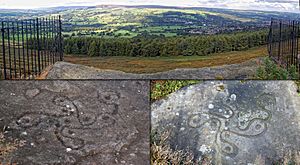Ilkley Moor facts for kids
Quick facts for kids Ilkley Moor |
|
|---|---|

Cow and Calf rocks
|
|
| Highest point | |
| Elevation | 402 m (1,319 ft) |
| Prominence | c. 244 metres (801 ft) |
| Parent peak | Thorpe Fell Top |
| Listing | Marilyn |
| Geography | |
| Location | West Yorkshire, United Kingdom |
| OS grid | SE114452 |
| Topo map | OS Landranger 104 |
Ilkley Moor is a famous area of moorland in West Yorkshire, England. It's located between the towns of Ilkley and Keighley (say: Kee-th-lee). This moor is quite high, reaching 402 meters (about 1,319 feet) above sea level. It's especially famous because it inspired a well-known Yorkshire song called On Ilkla Moor Baht 'at. That song's title means 'on Ilkley Moor without a hat' in the local dialect!
Contents
How Ilkley Moor Was Formed
Ancient Seas and Rivers
About 325 million years ago, during the Carboniferous period, Ilkley Moor looked very different. It was a swampy area at sea level. Rivers flowed into it from the north. Over millions of years, these rivers and tides left behind layers of mud and sand.
From Sediment to Rock
Slowly, these layers of sediment were pressed and glued together. They turned into hard rock. Later, huge natural forces lifted and tilted these rock layers. This created many small cracks, or faults, in the ground.
The Ice Age's Touch
After the Carboniferous period, a lot of rock wore away. More than a thousand meters of coal-rich rocks disappeared from the area. Then, during the last million years, Ice Age glaciers changed the shape of the Wharfe valley. They made it deeper and smoother. They also left behind rocks and dirt from the glaciers.
The Famous Gritstone
The main type of rock here is called millstone grit. This rock gives Ilkley its special look. It also makes the soil acidic, which is why you see lots of heather on the moor. It also creates soft water and rocky cliffs.
History of Ilkley Moor
The Cow and Calf Rocks
On the northern side of the moor, near Ben Rhydding, you'll find two popular rock climbing spots. One of these is Ilkley Quarry, home to the famous "Cow and Calf" rocks. These are large rock formations made of millstone grit, a type of sandstone. They are called "Cow and Calf" because one rock is big, like a cow, and the other is smaller, sitting close by like a calf.
People say there used to be a "bull" rock too. But this rock was supposedly removed for building stone in the 1800s. However, no local historians have found proof that the "bull" ever existed.
The Legend of Giant Rombald
A fun legend explains how the Cow and Calf rocks were formed. It says that a giant named Rombald was running away from an enemy. He supposedly stomped on the rock as he jumped across the valley. This stomp split the Calf from the Cow. His enemy was said to be his angry wife! She dropped the stones she was carrying in her skirt. These stones formed another local rock group called The Skirtful of Stones.
Recent Events
In July 2006, a large fire broke out on the moor. It destroyed between a quarter and half of the moorland. Also, the BBC Television show Gunpowder (2017) filmed some scenes on Ilkley Moor.
Ancient Carvings: The Swastika Stone
On the northern edge of Ilkley Moor, you can find a stone with a special swastika-shaped pattern carved into it. This is known as the Swastika Stone. The image shows a modern copy of the carving on the right. The original, older carving is on the left.
This stone is just one of many ancient carved rocks on the moor. Other well-known ones include the 'Badger Stone' and 'Nebstone'. These are large, flat rocks or prominent boulders. They have cups, rings, and grooves cut into them. Experts believe these carvings were made during the late Neolithic or Bronze Age periods. Some carvings are simple cups. Others, like the Badger Stone, have complex patterns with many different parts. Rombald's Moor has the second-highest number of ancient carved stones in Europe! There is also a small stone circle called The Twelve Apostles.
The Ilkley Moor Alien Sighting
On December 1, 1987, a retired policeman named Phillip Spencer had a strange experience on the Moor. He saw and photographed what he believed was an alien creature. He said the creature quickly ran up a hill. It then signaled to him with its arm, as if telling him not to come closer. After following the creature, he saw a dome-shaped craft at the top of the hill. He said it shot into the air at an amazing speed. The Daily Telegraph newspaper even included this event in a 2011 list of the "Top 10 UFO incidents in the UK".
Protecting Ilkley Moor
Ilkley Moor is a very important natural area. It is part of the South Pennine Moors Site of Special Scientific Interest (SSSI). This means it's a special place for wildlife and nature. It's also part of the South Pennine Moors Special Protection Area (SPA) and Special Area of Conservation (SAC). These titles mean the moor is protected for its important habitats and species.
The Friends of Ilkley Moor is a group founded in 2008. They work with others to help protect and preserve the moor for everyone to enjoy.



